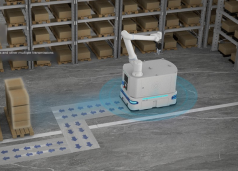QR Code

About Us
Products
Contact Us

Phone

E-mail

With the continuous development of intelligent manufacturing technology, composite robots have gradually become the main force in the loading and unloading process of the manufacturing industry. They have achieved efficient material handling and precise placement through advanced visual recognition, precise positioning and other technologies, injecting new vitality into the intelligent upgrading of the manufacturing industry.

1、 Concept and Characteristics of Composite Robots
Composite robot is a type of robot that integrates multiple technologies. It combines hardware such as robotic arms, sensors, and actuators, as well as advanced control systems and algorithms, to achieve highly autonomous work.
Fuwei Intelligent Composite Robot integrates collaborative robots, mobile robots, and visual guidance technology, equipped with ICD series core controllers to control the entire composite robot system in an integrated manner. It can also be connected to production line systems and equipped with self-developed 2D/3D visual platforms to easily achieve high-precision material grasping and placement functions. By flexibly integrating multiple functions such as hands, feet, eyes, and brain, it can meet the collaborative transportation needs of various complex scenes.
2、 Reasons for the popularity of research on composite robots
Scenario universality: Composite robots exhibit stronger scenario universality. Due to its modular design, users can freely adjust and optimize the various modules of the robot according to their own needs and creativity, making it more convenient to develop solutions that are suitable for various application scenarios. In the context of Industry 4.0, with the continuous evolution of robot technology, enterprises are facing the challenge of flexible production. In order to meet this demand, many enterprises and research institutions are committed to secondary development of the program for composite robots, so as to better adapt to different production scenarios and meet various application needs. This trend reflects the practical application prospects of modular technology in the future.
Flexibility: The composite robot combines the advantages of AGV/AMR and robotic arms, demonstrating higher factory flexibility. It can not only adapt to different production environments, but also generate large torque and maintain stable movements. Composite robots are closer to people's expectations for the ultimate form of robots, which is to achieve the perfect integration of "brain, eyes, hands, and feet". With the advancement of component technology in recent years, composite robots have significantly improved in terms of mobility accuracy, path flexibility, and ease of operation, further promoting the development of technological collaboration.

Customization: Through flexible hardware configuration, personalized software programming, precise integration adjustments, and task optimization for specific applications, composite robots can meet various unique needs and adapt to complex scenarios.
Highly autonomous: With the continuous advancement of technologies such as sensors and control algorithms, composite robots are increasingly capable of highly autonomous capabilities. This makes it possible for robots to work in complex environments, greatly expanding their application scope.
In summary, composite robots have become a hot research topic today due to their modular and customized features. With the continuous advancement of technology and the increasing demand for applications, the future development prospects of composite robots are broad. Through continuous in-depth research and innovative development, we have reason to believe that composite robots will bring more surprises and value to humanity in the future.




Copyright © 2024 Guangzhou Fuwei Electronic Technology Co., Ltd. All Rights Reserved.
Links | Sitemap | RSS | XML | Privacy Policy |

